Properties
| Storage Buffer | PBS pH7.2, 50% glycerol, 0.09% sodium azide *Storage buffer may change when conjugated |
| Storage Temperature | -20ºC, Conjugated antibodies should be stored according to the product label |
| Shipping Temperature | Blue Ice or 4ºC |
| Purification | Peptide Affinity Purified |
| Clonality | Polyclonal |
| Specificity | Detects the C-terminal domain of Calnexin ~90kDa. Weak detection in Chicken, Drosophila, and Xenopus tissues. |
| Cite This Product | StressMarq Biosciences Cat# SPC-182, RRID: AB_2068990 |
| Certificate of Analysis | A 1:2000 dilution of SPC-182 was sufficient for detection of Calnexin in 10 µg of HeLa cell lysate by ECL immunoblot analysis. |
Biological Description
| Alternative Names | Calnexin antibody, CALX_HUMAN antibody, CANX antibody, CNX antibody, FLJ26570 antibody, Histocompatibility complex class I antigen binding protein p88 antibody, IP90 antibody, Major histocompatibility complex class I antigen-binding protein p88 antibody, P90 antibody |
| Research Areas | Cell Signaling, Organelle Markers, Tags and Cell Markers |
| Cellular Localization | Endoplasmic Reticulum, Endoplasmic reticulum membrane, Melanosome |
| Accession Number | NP_001003232.1 |
| Gene ID | 403908 |
| Swiss Prot | P24643 |
| Scientific Background | Calnexin, an abundant ~90kDa integral protein of the endoplasmic reticulum, is also referred to as IP90, p88 and p90 (1). It consists of a large 50kDa N-terminal calcium-binding luminal domain, a single transmembrane helix and a short acidic cytoplasmic tail (2, 3). Unlike its ER counterparts which have a KDEL sequence on their C-terminus to ensure ER retention (4), calnexin has positively charged cytosolic residues that do the same thing (3). Most ER proteins act as molecular chaperones and participate in the proper folding of polypeptides and their assembly into multi-subunit proteins. Calnexin together with calreticulin, plays a key role in glycoprotein folding and its control within the ER, by interacting with folding intermediates via their mono-glycosylated glycans (5, 6). Calnexin has also been shown to associate with the major histocompatibility complex class I heavy chains, partial complexes of the T cell receptor and B cell membrane immunoglobulin (7). |
| References |
1. Rajagopalan S., Xu Y., and Brenner M.B. (1994) Science. 263(5145): 387-90. 2. Tjoelker L.W., et al. (1994) Biochemistry. 33: 3229. 3. Schrag J. et al. (2001) Molecular Cell. 8(3): 633-644. 4. Janiszewski M. (2005) J. Biol Chem. 280(49): 40813-40819. 5. Elagoz A., Callejo M., Armstrong J., and Rokeach L. A. (1999) J. Cell Sci. 112: 4449-4460. 6. Otteken A. and Moss B. (1996) J Bio Chem. 271(1): 97-103. 7. Galvin K. et al. (1992) Proc Natl Acad Sci USA. 89(18): 8452-6. |
Product Images

Immunocytochemistry/Immunofluorescence analysis using Rabbit Anti-Calnexin-CT Polyclonal Antibody (SPC-182). Tissue: Heat Shocked Cervical cancer cell line (HeLa). Species: Human. Fixation: 2% Formaldehyde for 20 min at RT. Primary Antibody: Rabbit Anti-Calnexin-CT Polyclonal Antibody (SPC-182) at 1:80 for 12 hours at 4°C. Secondary Antibody: FITC Goat Anti-Rabbit (green) at 1:200 for 2 hours at RT. Counterstain: DAPI (blue) nuclear stain at 1:40000 for 2 hours at RT. Localization: Endoplasmic reticulum membrane. Melanosome. Magnification: 100x. Heat Shocked at 42°C for 1h.
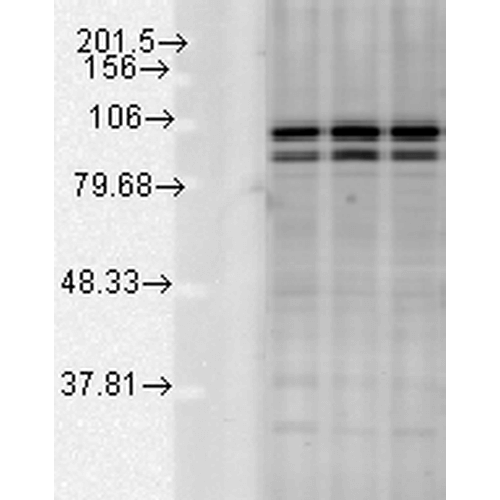
Western blot analysis of Rat tissue mix showing detection of Calnexin-CT protein using Rabbit Anti-Calnexin-CT Polyclonal Antibody (SPC-182). Load: 15 µgprotein. Block: 1.5% BSA for 30 minutes at RT. Primary Antibody: Rabbit Anti-Calnexin-CT Polyclonal Antibody (SPC-182) at 1:1000 for 2 hours at RT. Secondary Antibody: Donkey Anti-Rabbit IgG: HRP for 1 hour at RT.
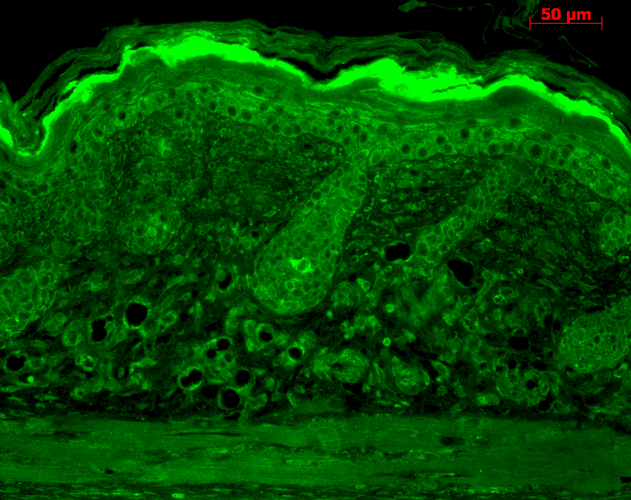
Immunohistochemistry analysis using Rabbit Anti-Calnexin-CT Polyclonal Antibody (SPC-182). Tissue: backskin. Species: Mouse. Fixation: Bouin’s Fixative Solution. Primary Antibody: Rabbit Anti-Calnexin-CT Polyclonal Antibody (SPC-182) at 1:100 for 1 hour at RT. Secondary Antibody: FITC Goat Anti-Rabbit (green) at 1:50 for 1 hour at RT. Localization: Hair Follicles, Basal cells in epidermis, and second layer of epidermis.
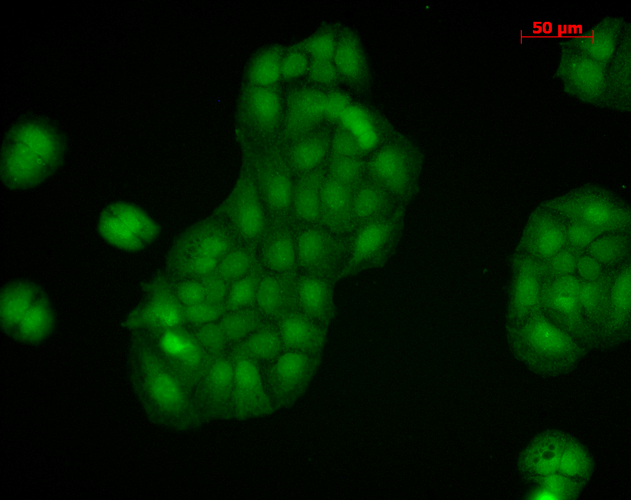
Immunocytochemistry/Immunofluorescence analysis using Rabbit Anti-Calnexin-CT Polyclonal Antibody (SPC-182). Tissue: HaCaT cells. Species: Human. Fixation: Cold 100% methanol at -20C for 10 minutes. Primary Antibody: Rabbit Anti-Calnexin-CT Polyclonal Antibody (SPC-182) at 1:100 for 12 hours at 4°C. Secondary Antibody: FITC Goat Anti-Rabbit at 1:50 for 1-2 hours at RT in dark. Localization: Nuclear staining, cytoplasmic staining.

Immunocytochemistry/Immunofluorescence analysis using Rabbit Anti-Calnexin-CT Polyclonal Antibody (SPC-182). Tissue: Heat Shocked Cervical cancer cell line (HeLa). Species: Human. Fixation: 2% Formaldehyde for 20 min at RT. Primary Antibody: Rabbit Anti-Calnexin-CT Polyclonal Antibody (SPC-182) at 1:80 for 12 hours at 4°C. Secondary Antibody: R-PE Goat Anti-Rabbit (yellow) at 1:200 for 2 hours at RT. Counterstain: DAPI (blue) nuclear stain at 1:40000 for 2 hours at RT. Localization: Endoplasmic reticulum membrane. Melanosome. Magnification: 20x. (A) DAPI (blue) nuclear stain. (B) Anti-Calnexin-CT Antibody. (C) Composite. Heat Shocked at 42°C for 1h.

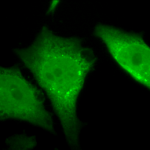
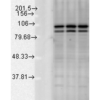
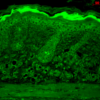
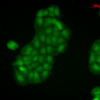
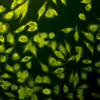




















Reviews
There are no reviews yet.